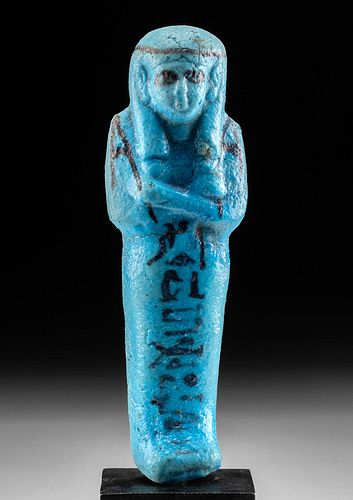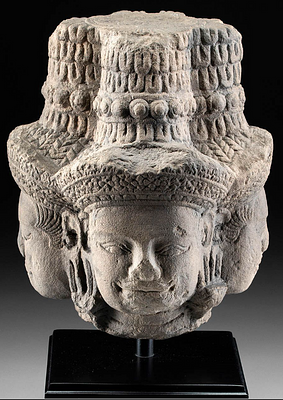Egyptian Ushabti for Ta-Shed-Khonsu, ex-Christie's, ex-Drexel
About Seller
686 S Taylor Ave, Ste 106
Louisville, CO 80027
United States
Selling antiquities, ancient and ethnographic art online since 1993, Artemis Gallery specializes in Classical Antiquities (Egyptian, Greek, Roman, Near Eastern), Asian, Pre-Columbian, African / Tribal / Oceanographic art. Our extensive inventory includes pottery, stone, metal, wood, glass and textil...Read more
Two ways to bid:
- Leave a max absentee bid and the platform will bid on your behalf up to your maximum bid during the live auction.
- Bid live during the auction and your bids will be submitted real-time to the auctioneer.
Bid Increments
| Price | Bid Increment |
|---|---|
| $0 | $25 |
| $300 | $50 |
| $1,000 | $100 |
| $2,000 | $250 |
| $5,000 | $500 |
| $10,000 | $1,000 |
| $20,000 | $2,500 |
| $50,000 | $5,000 |
| $100,000 | $10,000 |
| $200,000 | $20,000 |
About Auction
Jun 29, 2023
Artemis Fine Arts info@artemisfinearts.com
- Lot Description
Ancient Egypt, Third Intermediate Period, 21st Dynasty, ca. 1075 to 945 BCE. A spectacular faience ushabti made for Tent-Shed-Khonsu (or Ta-Shed-Khonsu), an ancient Egyptian lady whose name translates to "the one that Khonsu saves." Enveloped in a brilliant hue of azure, the figure stands mummiform with legs together and arms crossed at the chest, each holding a hoe. Black painted hieroglyphs are inscribed down her body, translating to "The illuminated one, the Osiris, Tent-Shed-Khonsu, true of voice." Crowned by a tripartite wig and a headband, her visage displays a finely formed expression for the period with enlarged eyes, prominent ears, and a petite nose and mouth. Her headband ties in the back as she carries a sack on her back. Size: 1.6" W x 4.9" H (4.1 cm x 12.4 cm); 6.5" H (16.5 cm) on included custom stand.
Shabti were placed in tombs as grave goods, created to do manual labor for the deceased in the afterlife. As a result, they are frequently depicted with arms crossed, holding hoes and baskets. Towards the end of the Pharaonic period, they had become so necessary and elaborate that some tombs contained one worker for every day of the year and thirty-six overseers, each responsible for ten laborers. Workers like this one are from that period of enormous proliferation and are some of our best surviving insights into ancient Egyptian funerary practices. Many, like this one, are inscribed with pleas to Osiris.
Similar ushabti for Tent-Shed-Khonsu can be found in the National Museums Liverpool (56.22.654, 56.22.649, and 1963.188.36).
This piece has been exhibited at the Robert and Frances Fullerton Museum of Art in San Bernardino, California from 1997 to 2011 and the California State University, San Bernardino Art Gallery in 1992.
Provenance: Collection of Dr. W. Benson Harer, Los Angeles, California, USA; ex-Christie's New York, New York, USA, Sale BES 3403, December 11, 2014, lot 65; ex- Ronald and Noel Mele, New York, USA, acquired in 1975; ex-Blumka Gallery, New York, USA, acquired in 1958; ex-Minneapolis Institute of Art, Minneapolis, Minnesota, USA, acquired in 1916 (inventory no. 16.381); ex-Drexel Institute, Philadelphia, Pennsylvania, USA, acquired in 1895; ex-Colonel Anthony J. Drexel, Jr. (1864-1934) collection, Philadelphia, Pennsylvania, USA; ex-Emile Brugsch (1842-1930) collection, curator of the Bulaq Museum, Cairo, Egypt
All items legal to buy/sell under U.S. Statute covering cultural patrimony Code 2600, CHAPTER 14, and are guaranteed to be as described or your money back.
A Certificate of Authenticity will accompany all winning bids.
We ship worldwide and handle all shipping in-house for your convenience.
#178996Condition
Some light surface wear with nicks and pitting commensurate with age as shown. Stable hairline fissure wraps horizontally around waist. Otherwise, intact and excellent with impressive remaining pigments and detail. Light patina in areas. Modern pin set in base for attachment to stand. Old Christie's New York label still attached.
- Shipping Info
-
All shipping is handled in-house for your convenience. Your invoice from Artemis Gallery will include shipping calculation instructions. If in doubt, please inquire BEFORE bidding for estimated shipping costs for individual items.
-
- Buyer's Premium



 EUR
EUR CAD
CAD AUD
AUD GBP
GBP MXN
MXN HKD
HKD CNY
CNY MYR
MYR SEK
SEK SGD
SGD CHF
CHF THB
THB











